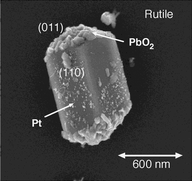Crystal faces of rutile and anatase TiO2 particles and their roles in photocatalytic reactions
Abstract
A titanium dioxide powder consisting of 1 μm size rutile and anatase particles was obtained, on which developed crystal faces were observed by a scanning electron microscope. From electron diffraction analyses, it was found that the rutile particles exposed {011} and {110} crystal faces, and the anatase particles exposed {001} and {011} faces. This powder showed high activity for some photocatalytic reactions, including oxidation of water. After photocatalytic oxidation of water on the powder using hexachloroplatinate(IV) ions as the electron acceptors, Pt deposits were observed mostly on the rutile particles, especially on the {110} face. When 2-propanol was added to the solution, Pt was deposited on both the anatase and rutile particles. Using the thus prepared Pt-deposited TiO2 powder, Pb2+ ions were photocatalytically oxidized into PbO2. After this reaction, PbO2 deposits were seen on the {011} face of the rutile particles. On the anatase particles, PbO2 deposits were observed in a larger amount on the {001} face than on the {011} face. These results indicate that the crystal faces help in the separation of electrons and holes, and that this effect is stronger for the rutile particles than for the anatase particles.


 Please wait while we load your content...
Please wait while we load your content...